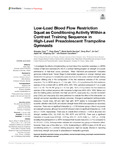Mostrar o rexistro simple do ítem
Low-Load Blood Flow Restriction Squat as Conditioning Activity Within a Contrast Training Sequence in High-Level Preadolescent Trampoline Gymnasts
| dc.contributor.author | Carballeira, Eduardo | |
| dc.contributor.author | Yang, Shengtao | |
| dc.contributor.author | Zhang, Peng | |
| dc.contributor.author | Sevilla-Sánchez, Marta | |
| dc.contributor.author | Zhou, Dong | |
| dc.contributor.author | Cao, Jie | |
| dc.contributor.author | He, Jiajian | |
| dc.contributor.author | Gao, Binghong | |
| dc.date.accessioned | 2024-03-04T13:51:45Z | |
| dc.date.available | 2024-03-04T13:51:45Z | |
| dc.date.issued | 2022-06-13 | |
| dc.identifier.citation | Yang S, Zhang P, Sevilla-Sanchez M, Zhou D, Cao J, He J, Gao B and Carballeira E (2022) Low-Load Blood Flow Restriction Squat as Conditioning Activity Within a Contrast Training Sequence in High-Level Preadolescent Trampoline Gymnasts. Front. Physiol. 13:852693. doi: 10.3389/fphys.2022.852693 | es_ES |
| dc.identifier.issn | 2076-328X | |
| dc.identifier.uri | http://hdl.handle.net/2183/35781 | |
| dc.description.abstract | [Abstract] To investigate the effects of implementing low-load blood flow restriction exercises (LL-BFRE) instead of high-load exercises (HL-RE) in a contrast training program on strength and power performance of high-level young gymnasts. Fifteen high-level pre-pubescent trampoline gymnasts (national level, Tanner Stage II, intermediate experience in strength training) were divided into two groups to complete the same structure of a ten-week contrast strength training program differing only in the configuration of the first resistance exercise of the contrast sequence. The LL-BFRE group (n = 7, four girls, 13.9 ± 0.4 y) performed the first resistance exercise of the contrast with LL-BFRE (20%–30% 1RM, perceived pressure of 7 on a scale from 0 to 10). The HL-RE group (n = 8, four girls, 13.8 ± 0.5 y) trained the first resistance exercise of the contrast sequence with moderate-to-high load (60%–85% 1RM). Before and after the training period, isometric mid-thigh pull (IMTP), squat jump (SJ), counter movement jump (CMJ), and drop-jump (DJ) were performed to evaluate the effect of the intervention on strength and power capacities as primary outcomes. Changes in participants’ anthropometric measures, muscle mass, left and right thigh girth, IMTP relative to bodyweight (IMTP-R), eccentric utilization ratio (EUR), and reactive strength index (RSI) were assessed as secondary outcomes. There was no significant interaction (p > 0.05) between group x time in any power and strength outcome, although SJ and EUR showed a trend to significant interaction (p=0.06 and p = 0.065, respectively). There was an overall effect of time (p < 0.05) in all power and strength variables (CMJ, SJ, EUR, DJ, RSI, IMTP, and IMTP-R). There was a significant interaction in muscle mass (MM) [β = 0.57 kg, 95% CI = (0.15; 0.98), t13 = 2.67, p = 0.019], revealing that participants in LL-BFRE increased their muscle mass (6.6 ± 3.1%) compared to HL-RE (3.6 ± 2.0%). Anthropometric variables did not present any group or interaction effect. However, there was a time effect (p < 0.05). Implementing LL-BFRE in place of HL-RE as a conditioning activity in a contrast training sequence might be equally effective in improving lower-body strength and power in preadolescent trampoline gymnasts. | es_ES |
| dc.language.iso | eng | es_ES |
| dc.publisher | Frontiers | es_ES |
| dc.relation.uri | https://doi.org/10.3389/fphys.2022.852693 | es_ES |
| dc.rights | CCBY 4.0 | es_ES |
| dc.rights.uri | http://creativecommons.org/licenses/by/3.0/es/ | * |
| dc.subject | Blood flow restriction training | es_ES |
| dc.subject | Young athletes | es_ES |
| dc.subject | Contrast strength training | es_ES |
| dc.subject | Jump height | es_ES |
| dc.subject | Maximal isometric strength | es_ES |
| dc.subject | High-load resistance exercise | es_ES |
| dc.title | Low-Load Blood Flow Restriction Squat as Conditioning Activity Within a Contrast Training Sequence in High-Level Preadolescent Trampoline Gymnasts | es_ES |
| dc.type | info:eu-repo/semantics/article | es_ES |
| dc.rights.access | info:eu-repo/semantics/openAccess | es_ES |
| UDC.journalTitle | Frontiers in Physiology | es_ES |
| UDC.volume | 13 | es_ES |
Ficheiros no ítem
Este ítem aparece na(s) seguinte(s) colección(s)
-
GI-PHG - Artigos [102]






